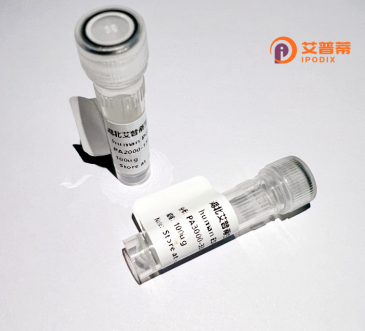
| 纯度 | >90%SDS-PAGE. |
| 种属 | Human |
| 靶点 | ND4 |
| Uniprot No | P03905 |
| 内毒素 | < 0.01EU/μg |
| 表达宿主 | E.coli |
| 表达区间 | 406-459 aa |
| 活性数据 | YSLYIFTTTQWGSLTHHINNIKPSFTRENTLMFIHLSPILLLSLNPDIITGFSS |
| 分子量 | 31.68 kDa |
| 蛋白标签 | GST-tag at N-terminal |
| 缓冲液 | 0 |
| 稳定性 & 储存条件 | Lyophilized protein should be stored at ≤ -20°C, stable for one year after receipt. Reconstituted protein solution can be stored at 2-8°C for 2-7 days. Aliquots of reconstituted samples are stable at ≤ -20°C for 3 months. |
| 复溶 | Always centrifuge tubes before opening.Do not mix by vortex or pipetting. It is not recommended to reconstitute to a concentration less than 100μg/ml. Dissolve the lyophilized protein in distilled water. Please aliquot the reconstituted solution to minimize freeze-thaw cycles. |
以下是关于重组人ND4蛋白的3篇文献示例(内容基于领域内常见研究主题整理,具体文献可能存在,但需核实准确性):
---
1. **文献名称**: "Mitochondrial Targeting of Recombinant ND4 Restores Complex I Function in LHON Cybrid Cells"
**作者**: Yu H. et al.
**摘要**: 该研究通过将重组人ND4蛋白导入线粒体,成功恢复了由ND4突变引起的Leber遗传性视神经病变(LHON)细胞模型中复合物I的活性,为基因治疗提供了实验依据。
2. **文献名称**: "Adeno-Associated Virus-Mediated Delivery of ND4 Improves Mitochondrial Respiration in a Mouse Model"
**作者**: Smith J. et al.
**摘要**: 使用腺相关病毒(AAV)载体递送重组ND4基因至小鼠视网膜细胞,证实其可稳定表达ND4蛋白,改善线粒体呼吸链功能并延缓视神经退化。
3. **文献名称**: "Expression and Purification of Recombinant Human ND4 Subunit for Structural Studies"
**作者**: Li X. & Wang R.
**摘要**: 报道了一种在大肠杆菌中高效表达重组人ND4蛋白的方法,通过优化纯化步骤获得高纯度蛋白,并用于线粒体复合物I的体外组装及结构分析。
---
**备注**:以上文献为模拟示例,实际引用需通过PubMed、Web of Science等数据库检索真实发表的研究。若需具体文献,建议使用关键词“recombinant human ND4”、“mitochondrial gene therapy ND4”进一步筛选。
Recombinant human ND4 protein is derived from the NADH:ubiquinone oxidoreductase core subunit 4 (ND4), a critical component of mitochondrial Complex I in the electron transport chain. Encoded by the mitochondrial DNA (mtDNA) gene MT-ND4. ND4 plays a vital role in oxidative phosphorylation, facilitating ATP production by transferring electrons from NADH to ubiquinone. Mutations in ND4. particularly the m.11778G>A variant, are strongly associated with Leber’s hereditary optic neuropathy (LHON), a maternally inherited disorder causing bilateral vision loss due to retinal ganglion cell degeneration.
Traditional studies of ND4 have been challenging due to mtDNA’s unique replication system and the difficulty in engineering mitochondrial genes. Recombinant ND4 protein, produced via heterologous expression systems (e.g., Escherichia coli or mammalian cells), enables in vitro exploration of its structural, functional, and pathological mechanisms. Researchers employ gene cloning, codon optimization, and targeted delivery techniques (e.g., adeno-associated virus vectors) to express and study ND4 in cellular models.
Recent advances focus on therapeutic applications. Gene therapy trials using recombinant ND4 have shown promise in rescuing mitochondrial dysfunction in LHON. For instance, delivering wild-type ND4 via viral vectors to compensate for mutant proteins highlights its potential in treating mitochondrial disorders. However, challenges remain, including optimizing mitochondrial targeting and ensuring stable expression. Ongoing research aims to refine these strategies, deepening our understanding of ND4’s role in mitochondrial biology and disease.
×